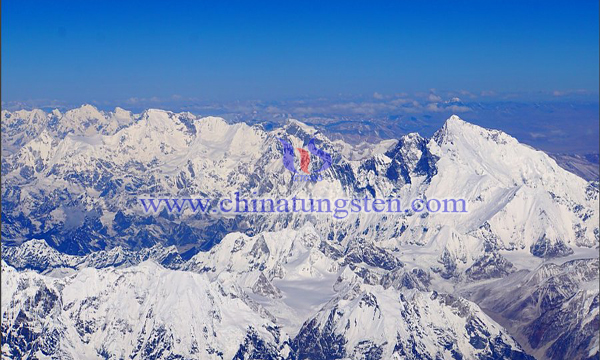A Large-Scale Bismuth-Tin-Tungsten Mine Has Been Found in Himalaya
- Details
- Category: Tungsten Information
- Published on Friday, 27 July 2018 18:31
According to China Geological Survey, scientists from the Chengdu Geological Survey under China Geological Survey identified a large gneiss dome structure in the south of the Zhaxikang mining area in the eastern Himalayas. The high-differential pale-colored granite has multi-period intrusion characteristics, and a thick silicon skarn-type bismuth-tin-tungsten rare metal ore body is found in the edge of the dome.

Through sparse surface engineering control, a new discovery of a rare bismuth-tin-tungsten rare metal mineral deposit was reached, reaching a super-large scale, revealing the Tibetan Himalayan metallogenic belt except for lead, zinc, gold, antimony and other minerals, antimony, tin and tungsten. Such rare metal minerals also have great potential. This discovery is of great significance for re-recognizing the mineralization of the Himalayan metallogenic belt and guiding regional prospecting.
According to reports, the newly discovered deposits in the Sinnadong area in the southern part of the Zhaxikang mining area are dominated by strontium, which is symbiotic with tin-tungsten, accompanied by beneficial components such as strontium-rubidium-niobium-tantalum, lead-zinc-copper and gold-silver. The preliminary investigation and evaluation results reveal that the Sinnadong polymetallic deposit is a skarn type, and the ore body is mainly produced in the outer contact zone of silicon skarn or silicon skarnized marble, and the strontium polymetallic ore body is layered. Shape or layer-like output, stable layer, uniform thickness variation, strontium-containing minerals are mainly silicon vermiculite, hydroxysilicon vermiculite, followed by fragrant stone, metal minerals are mainly cassiterite, scheelite, secondary yellow Copper ore, galena, pyrite, etc.
Although China's beryllium resources are abundant, there are few large-scale independent antimony mines and poor resource endowments. They are mainly associated with mines such as lithium, antimony and antimony. The average grade of mineral deposits is far lower than that of other countries. The first discovery of the super-large rare earth metal deposit in the south of the Zhaxikang mining area in Tibet has important theoretical and practical significance. The first is the newly discovered minerals and types in the Himalayan metallogenic belt in Tibet. The scale and potential are huge. It reveals the tip of the iceberg of the large-scale rare metal mineralization of the Miocene pale-colored granite in the Himalayan metallogenic belt, and promotes a new understanding of the Himalayan belt mineralization. The second is to open a new prospecting window, expand new prospecting areas and prospecting space, and confirm that the Himalayan metallogenic belt may become China's new strontium-tungsten-tin resource enrichment area, which will lead the region to find minerals and accelerate the western part of China. The construction of new rare metal bases is of great significance. The third is to establish a new successful example of mineralization theory in Tibet's self-contained exploration area, and to understand the Himalayan collisional orogeny and mineralization, which is of great significance to promote the theoretical innovation of the Qinghai-Tibet Plateau.
- Tungsten Manufacturer & Supplier, Chinatungsten Online: www.chinatungsten.com
- Tungsten News & Prices of China Tungsten Industry Association: www.ctia.com.cn
- Molybdenum News & Price: news.molybdenum.com.cn
- Tel.: 86 592 5129696; Fax: 86 592 5129797; Email: sales@chinatungsten.com



 sales@chinatungsten.com
sales@chinatungsten.com